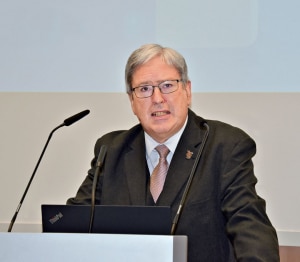
How rust can advance H2 technology
When iron rusts, it takes up oxygen. If this does not come from the air but from water vapor, hydrogen is left behind. This effect could become the basis for a new energy storage technology. Several research groups and companies are already working on bringing such a storage method based on ordinary iron to market. It would bind hydrogen and release it again at the desired time – and avoid the need for gas storage in the usual sense.
The loading and unloading of the storage medium is nothing other than the rusting of iron and its reversal as needed. To load the energy storage, hydrogen is streamed through pellets of rusted iron – or in chemical terms, of iron oxide. In doing so, the hydrogen pulls the oxygen out of the pellets and binds it to itself. The result is pure, metallic iron pellets and water vapor.
The energy of the hydrogen is essentially bound in the pellets. In this form, it can be easily stored or transported over large distances without the need for considerable safety precautions. To extract the energy again, steam is streamed through the iron pellets. The oxygen from the water vapor binds itself to the iron, and gaseous hydrogen remains.
The trick with the rust has several charms. Iron is highly abundant on earth, does not cost much, and can be transported and stored without much precaution. And the technology has another advantage still. Strictly speaking, the storage mediums made of iron do not contain any hydrogen at all, but merely absorb its energy content. During reloading of the medium, hydrogen is turned back into water. So the steam can therefore be, at least to some extent, recycled. This is particularly important in locations where water is a scarce resource, for example in desert regions where hydrogen is to be produced for Europe on a large scale in the future.
Iron storage in standard container
Like many energy transition technologies, the iron–steam process is not new. Howard Lane had already developed it in 1804. In the 1970s, an industrial plant in Magdeburg was already producing about 20,000 m3 hydrogen per hour this way. But for the modern applications, it needs a few adjustments to meet current requirements.
The startup Ambartec, in which the energy corporation Wintershall Dea has also invested, wants to use the process for hydrogen transport, among other things. For this, Ambartec intends to store iron pellets in 20-foot containers, which can be moved through all the normal shipping modes – from trucks for regional production to overseas transport by freighter. “For the process, a challenge is to condition the iron pellets such that they do not break into dust after only a few cycles or sinter onto the surface,” says Matthias Rudloff from Ambartec.
That has now been achieved by the company, according to its own statement. The demo pellet unit in Freiberg, about 40 kilometers away from the company headquarters in Dresden, has already stably gone through several hundred cycles. The next scaling stage is to come in May; another at the end of 2023. Ambartec wants to deliver the first small number of units to customers starting in 2024.
Besides the iron granules themselves, Ambartec has also worked on the controlling of the process. To provide the proper pressure and temperature gradients, a separate loading or unloading unit is used. “For the hydrogen unloading, steam that is produced in industrial plants could be integrated. The pressure in this is an important aspect, as the steam pressure essentially determines the hydrogen pressure,” says Rudloff.
The released hydrogen is saturated with steam, but otherwise relatively pure. Uses for the hydrogen-producing iron pellets Rudloff sees not only in freight transport but, in combination with an electrolysis and electricity regeneration unit, also as electrical energy storage for stationary applications and sea travel.
Ambartec storage system in numbers
Current scaling: 100 liters
Target size: 40-foot container
Density of iron pellets: 2.5 kg/L
Energy density (vol.): 0.4 kWh/L
Energy density (grav.): 1 kWh/kg
University research
A research team coordinated by Universität Duisburg-Essen is also dedicated to making use of the iron–steam process for hydrogen transport. Its partners are Technische Universität Clausthal and Leibniz IWT in Bremen, as well as Thyssenkrupp Steel Europe AG and the SMS group GmbH as associated industrial companies. The project Me2H2 Eisen-Dampf-Prozess is being supported by the German education and research ministry with 1.3 million euros over three years. A large part of the project will be dealing with the fundamentals like for example exploring suitable alloys. The project has just started, so there are no results to report yet.
Use in industry and trains
Another player is Wolf Energetik GmbH, which focuses primarily on the integration into large industrial processes. “We need energy storage on the dimension of coal piles or large oil tanks,” says Claudia Hain, who founded the company together with the eponymous Bodo Wolf as early as 2013. In this, Wolf Energetik is building on technology from the 1970s. “We did not need to develop the apparatus from scratch, but only to qualify it for new applications,” she says.
She sees an ideal electrical storage application of a closed-loop material process with a high-temperature electrolysis and fuel cell in which both heat and steam are reused again and again. Up to 80 percent storage efficiency would be possible this way, Hain is convinced. Instead of supplying turnkey plants for this themselves, Wolf Energetik wants to be a “technology giver” for industrial plant builders.
Another possible application of the patented technology would be the intermediate storage of hydrogen and the subsequent production of synthesis gas for industrial uses. The Mabanaft Group, which comes from the oil industry and is now working on e-fuel production in Chile and Norway, has already joined as a partner. “Also industrial companies based in Germany that require hydrogen on a continuous basis could use our storage technology to safeguard themselves against supply interruptions,” according to Hain.
In addition, Wolf Energetik is working on a mobile storage for use in trains. The preliminary work has started. A train as a model for the integration has already been selected. In Freiberg, middle of this year, a stationary pilot version is to appear as part of the project Future H Drive in which the storage unit and the reverse fuel cell are combined into a single system that could conceivably be installed in the vehicle. The goal of a subsequent project is then to actually integrate the technology into a train. Partner in this is the holding Deutsche Eisenbahn Service AG.
Author: Eva Augsten




